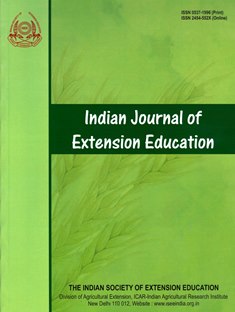Constraints in the Adoption of Stress Tolerant Rice Varieties (STRVs) in Odisha
DOI:
https://doi.org/10.48165/IJEE.2025.614RN02Keywords:
Constraints, Farmers, Garrett ranking, Information, Accessibility, Stress tolerant rice varieties, STRVsAbstract
The study investigated barriers to the adoption of stress-tolerant rice varieties (STRVs) among farmers in Odisha during 2024-2025. Data from 240 randomly selected farmers, collected via an ex-post facto design and analysed using Henry Garrett’s ranking technique. The analysis revealed key constraints across social, economic, managerial, technological, and organisational dimensions. Major barriers identified were low literacy, social marginalization, risk aversion, high input costs, limited financial literacy, weak post-adoption evaluation, insufficient STRV knowledge, inadequate demonstration trials, and poorly designed training programs. The results highlight the complex interplay of these obstacles and emphasise the need for comprehensive interventions–such as targeted literacy and capacity-building initiatives, improved financial support, adaptive extension services, and participatory demonstrations, all tailored to meet the needs of marginalized farmers to enhance STRV adoption in the countryside.
Downloads
References
Akter, T., Islam, S., Habib, M. A., Zhang, Y., Rouf, A., Nayak, S., Qin, X., McKenzie, A. M., & Zia, M. (2025). Farmers’ adoption of newly released climate resilient rice varieties in the coastal ecosystem of Bangladesh: Effectiveness of a head-to-head adaptive trial. Food and Energy Security, 14, e70075. https://doi.org/10.1002/fes3.70075
Arora, A., Bansal, S., & Ward, P. S. (2019). Do farmers value rice varieties tolerant to droughts and floods? Evidence from a discrete choice experiment in Odisha, India. Water Resources and Economics, 25, 27–41. https://doi.org/10.1016/j.wre.2018.03.001
Babu, G. P., Jayalakshmi, M., Chaitanya, B. H., Mahadevaiah, M., & Srinivas, T. (2021). Effectiveness of season-long training programme on knowledge levels in Kurnool district of Andhra Pradesh. Indian Journal of Extension Education, 57(4), 44–48. https://epubs.icar.org.in/index.php/IJEE/article/view/115481
Bahinipati, C. S. (2014). Assessment of vulnerability to cyclones and floods in Odisha, India: A district-level analysis. Current Science, 107(12), 1997–2007. https://www.jstor.org/stable/24216033
Dar, M. H., Bano, D. A., Waza, S. A., Zaidi, N. W., Majid, A., Shikari, A. B., Ahangar, M. A., Hossain, M., Kumar, A., & Singh, U. S. (2021). Abiotic stress tolerance – progress and pathways of sustainable rice production. Sustainability, 13(4), 2078. https://doi.org/10.3390/su13042078
Dar, M. H., Waza, S. A., Nayak, S., Chakravarty, R., Zaidi, N. W., & Hossain, M. (2020). Gender-focused training and knowledge enhances the adoption of climate resilient seeds. Technology in Society, 63, 101388. https://doi.org/10.1016/j.techsoc.2020.101388
Das, L., Nain, M. S., Singh, R., & Burman, R. R. (2014). Constraints in marketing of fruits as perceived by the fruit growers and NERAMAC in Assam. Journal of Community Mobilization and Sustainable Development, 9(2), 114–117.
Das, N., Modak, S., Prusty, A. K., Saha, P., & Suman, S. (2025). Understanding and overcoming key challenges of agripreneurs in Southern Odisha: A case study. Indian Journal of Extension Education, 61(2), 118–122. https://epubs.icar.org.in/index.php/IJEE/article/view/165221
Dibba, L., Zeller, M., & Diagne, A. (2018). The impact of agricultural training on the technical efficiency of smallholder rice producers in the Gambia. Modern Concepts and Developments in Agronomy, 2(3), 1–12. http://dx.doi.org/10.31031/mcda.2018.02.000537
Garrett, H. E., & Woodworth, R. S. (1969). Statistics in psychology and education (p. 329). Feffer and Simons Pvt. Ltd., Vakils.
Gireesh, S., Kumbhare, N. V., Nain, M. S., Kumar, P., & Gurung, B. (2019). Yield gap and constraints in production of major pulses in Madhya Pradesh and Maharashtra. Indian Journal of Agricultural Research, 53(1), 104–107.
Hareesh, A. (2017). A study on the impact of agricultural programmes of ITDA on tribal farmers in Vizianagaram district of Andhra Pradesh [M.Sc. (Ag.) thesis, Acharya N. G. Ranga Agricultural University, Lam, Guntur, Andhra Pradesh, India].
Jayasingh, D. K., & Mishra, B. (2024). Factors influencing occupational diversification among farmers in Khordha district of Odisha. Indian Journal of Extension Education, 60(3), 37–41. https://epubs.icar.org.in/index.php/IJEE/article/view/151291
Khanam, T. S. (2023). Factors affecting the adoption of stress tolerant rice varieties. The Bangladesh Development Studies, 44(3–4), 33–56. https://doi.org/10.57138/VQFL9457
Kumar, S., Nain, M. S., Sangeetha, V., & Satyapriya. (2023). Determinants and constraints for adoption of zero budget natural farming (ZBNF) practices in farmer field school. Indian Journal of Extension Education, 59(4), 135–140. https://doi.org/10.48165/IJEE.2023.59427
Mangaraj, S., Sahu, S., Panda, P. K., Rahman, F. H., Bhattacharya, R., Patri, D., Mishra, P. J., Phonglosa, A., & Satapathy, S. K. (2021). Assessment of stress tolerant rice varieties under rainfed condition in North Eastern Ghat of Odisha. International Journal of Environment and Climate Change, 11(4), 128–134. https://doi.org/10.9734/ijecc/2021/v11i430400
Mehar, M., Padmaja, S. S., & Prasad, N. (2022). Coping with climate stress in Eastern India: Farmers’ adoption of stress-tolerant rice varieties. Asian Journal of Agriculture and Development, 19(1), 43–60. http://dx.doi.org/10.22004/ag.econ.321902
Mohanta, B., Satapathy, S., Sahoo, J., Sarkar, D., Mishra, P. J., & Phonglosa, A. (2024). Performance evaluation of stress tolerant rice variety Swarna Shreya under front-line demonstration in Bolangir district, Odisha. International Journal of Environment and Climate Change, 14(9), 681–686. https://doi.org/10.9734/ijecc/2024/v14i94446
Murali Krishna, G., Panjala, P., Gupta, S. K., Sehgal, V. K., Deevi, K. C., Are, A. K., Bellam, P. K., Mohanty, M. R., Swain, S. K., Sawargaonkar, G., Habyarimana, E., & Padhee, A. K. (2025). Geospatial analysis to identify millet suitable areas in the upland rice ecosystem of Odisha. Journal of Agriculture and Food Research, 19, 101593. https://doi.org/10.1016/j.jafr.2024.101593
Muthukumar, R., Sindhuja, R., & Jayasankar, R. (2020). Constraints faced by the paddy growers in adopting the post-harvest technologies. Plant Archives, 20(2), 3789–3790. https://www.plantarchives.org/SPL%20ISSUE%2020-2/619__3789-3790_.pdf
Ojo, I. E., Akangbe, J. A., Kolawole, E. A., Owolabi, A. O., Obaniyi, K. S., Ayeni, M. D., Adeniyi, V. A., & Awe, T. E. (2024). Constraints limiting the effectiveness of extension agents in disseminating climate-smart agricultural practices among rice farmers in North-Central Nigeria. Frontiers in Climate, 6, 1297225. https://doi.org/10.3389/fclim.2024.1297225
Patil, V., & Veettil, P. C. (2024). Farmers’ risk attitude, agricultural technology adoption and impacts in Eastern India. Agriculture & Food Security, 13, 50. https://doi.org/10.1186/s40066-024-00497-x
Planning and Convergence Department, Directorate of Economics and Statistics. (2025). Odisha Economic Survey 2024–25. Government of Odisha. https://pc.odisha.gov.in/publication/economic-survey-report
Raghu, P. T., Veettil, P. C., & Das, S. (2025). Drought adaptation and economic impacts on smallholder rice farmers. Agriculture Communications, 3(1), 100075. https://doi.org/10.1016/j.agrcom.2025.100075
Sabu, P. J., & Roy, D. (2024). Constraints faced by paddy farmers in Kerala: An empirical analysis in Palakkad. Indian Journal of Extension Education, 60(4), 136–139. https://epubs.icar.org.in/index.php/IJEE/article/view/152004
Saha, P., Prusty, A. K., Nanda, C., Ray, S., & Sahoo, B. (2024). Professional insights provided by women extension personnel in Odisha. Indian Journal of Extension Education, 60(3), 101–105. https://epubs.icar.org.in/index.php/IJEE/article/view/151879
Sangeetha, S., Venkata Prabhu, J., Indumathy, K., & Vaidehi, G. (2018). Constraints experienced by paddy farmers in adaptation to climate change. Plant Archives, 18(1), 1057–1060. https://www.cabidigitallibrary.org/doi/pdf/10.5555/20183312446
Sinha, R., Peláez-Vico, M. A., Shostak, B., Nguyen, T. T., Pascual, L. S., Ogden, A. M., Lyu, Z., Zandalinas, S. I., Joshi, T., Fritschi, F. B., & Mittler, R. (2023). The effects of multifactorial stress combination on rice and maize. Plant Physiology, 194(3), 1358–1369. https://doi.org/10.1093/plphys/kiad557
Swain, D. P., Goswami, A., Das, B. C., Singh, B. P., Govil, K., & Sant, S. (2024). Impact of drought on the livelihoods of farmers in Western Odisha: A comparison between drought and non-drought years. Archives of Current Research International, 24(6), 286–292. https://doi.org/10.9734/acri/2024/v24i6786
Usha, M., Rambabu, P., Gopi Krishna, T., Martin Luther, M., & Srinivasa Rao, V. (2021). Constraints faced by the rice farmer beneficiaries of Rastriya Krishi Vikas Yojana (RKVY) in adoption of recommended ANGRAU technologies. Asian Journal of Agricultural Extension, Economics & Sociology, 39(6), 118–126. https://doi.org/10.9734/ajaees/2021/v39i630599
Vaiknoras, K., & Larochelle, C. (2025). Measuring the impact of stress-tolerant rice variety adoption: Evidence on input use and yield in Nepal. Agricultural Economics, 56, 145–160. https://doi.org/10.1111/agec.12869
Vergara, G. V., Srey, S., Flor, R. J., Ouk, A., Keo, S., Seyla, S., Leng, L., Uch, C., Velasco, L., Valencia, S., Laborte, A., Pede, V., Hadi, B. A., & Ismail, A. M. (2023). Enabling adoption of stress tolerant rice varieties and associated production management technologies by smallholder farmers in Cambodia. Asian Journal of Agriculture and Development, 20(1), 53–70. https://doi.org/10.37801/ajad2023.20.1.4
Yamano, T., Dar, M. H., Panda, A., Gupta, I., Malabayabas, M. L., & Kelly, E. (2018). Impact and adoption of risk-reducing drought tolerant rice in India (3ie Impact Evaluation Report 72). International Initiative for Impact Evaluation. https://www.3ieimpact.org/sites/default/files/2019-01/IE72-India-drought-tolerant_0.pdf
Downloads
Published
Issue
Section
License

This work is licensed under a Creative Commons Attribution-NonCommercial-NoDerivatives 4.0 International License.

